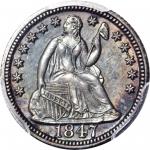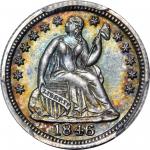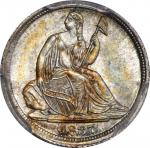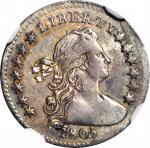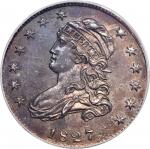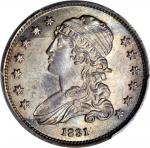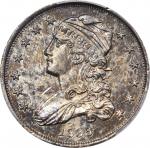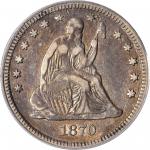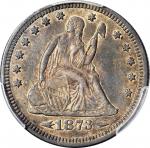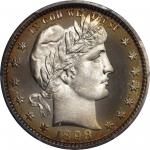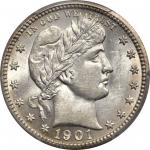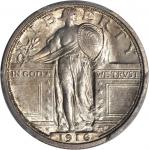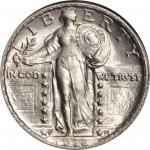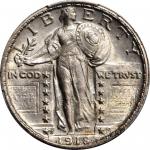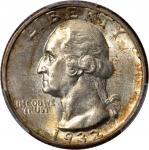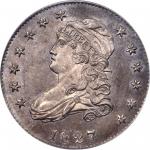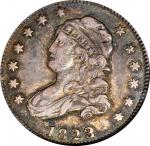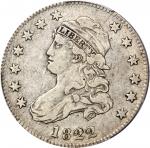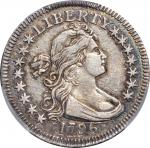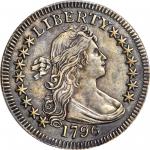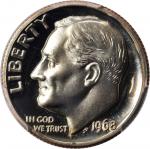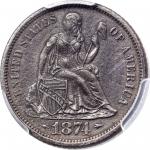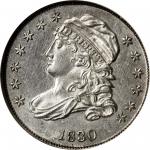1827/3/2 Capped Bust Quarter. Restrike. B-2. Rarity-6+. Square Base 2 in 25 C. Proof-65 (NGC). Only in the most significant numismatic auctions, and often with many years in between, do advanced collectors have the opportunity to view, bid on and even acquire examples of both the Original and Restrike 1827/3/2 quarter, a landmark rarity in the U.S. series. While not quite as rare as the Originals, the Restrikes are just as challenging to find in the market, and every bit as desirable as representatives of this legendary Capped Bust quarter date. Indeed most, if not all of the Restrikes were created with the sole purpose of representing this prized date in numismatic collections.<p>As related above in our description for the Mickley-Norweb specimen of the Original 1827/3/2 quarter, all examples of this date were struck from the same obverse die whose final form was prepared in the Mint sometime in 1827. The Restrikes, however, are from a different reverse die, in this case the die used previously by the Mint for the 1819 Browning-2 pairing. Attributed as B-2, the Restrike 1827/3/2 quarters are easily distinguished from their Original B-1 counterparts by the Square Base 2 in the denomination 25 C.<p>At least two striking periods are known for the 1827 B-2 quarters, identifiable by the lack or presence of die rust on the obverse and/or reverse dies. These will be considered separately, as the coins struck during each period were made for two very different reasons.<p><strong>Early Die State Coins</strong><p>Only two examples of this classification are known, both silver impressions and, interestingly, both overstruck on Draped Bust quarters. Displaying the sharpest strikes seen on any 1827-dated quarters, these two coins were obviously struck twice and are thought to have been produced as part of experiments with a close collar or steam press. Both specimens are also free of die rust, a feature that readily distinguishes them from other examples from this die pairing. Opinions differ as to when these two special coins were struck. Karl Moulton asserts that these are actually the first two 1827-dated quarters struck (in 1827), to test production of quarters using the close collar. On the other hand, Saul Teichman places their striking period in the mid 1830s as part of the Mints preparations for the introduction of both the steam press and close collar in the regular issue production of half dollars and silver dollars. Pedigreed to famous collections, these two early die state coins are known as the Eliasberg and James A. Stack specimens. Regardless of when they were struck, these coins were obviously part of experimentation on the part of the Mint and, as such, are more accurately described as "Essay" pieces as opposed to Restrikes. Accordingly, they have been assigned the attribution Judd-48A on the <em>uspatterns.com</em> website.<p><strong>Late Die State Coins</strong><p>These are the more familiar Restrike 1827/3/2 quarters, whose story begins with the growth in popularity of the numismatic hobby in the United States during the second half of the 19th century. During the final decades of that century, the 1827 quarter was one of the most famous and eagerly sought numismatic rarities. In order to provide contemporary collectors with examples and to benefit from doing so, Mint employees retrieved the 1827-dated quarter die pairing used for the two Essay coins and employed them to produce a small number of restrikes. In the intervening decades between these striking periods, the dies had become quite rusted.<p>Interestingly, the earliest Restrikes from the 1827/3/2 B-2 dies were in copper, of which five specimens are known, one of which has been silver plated. These coins are from rusted dies, as above, but show no evidence of a curious depression on Libertys bust, just in front of the curl. Two of the silver Restrikes are from this same die state and were obviously made concurrently with the copper impressions.<p>The Mints final production of 1827/3/2 quarters accounts for most of the silver Restrike B-2 coins. These pieces show evidence of extensive die rust on both the obverse and reverse, as well as the depression on Libertys bust. The latter feature is likely the result of a scrap of metal or other foreign object adhering to the obverse die during the press run for these particular Restrikes.<p>All Restrike 1827/3/2 B-2 quarters, silver and copper, with or with depression on the bust, almost certainly date to the 1870s. More specifically, they were probably struck during Henry R. Lindermans second term as director of the Mint, 1873 to 1878. During this period, many restrikes, mulings, so-called "patterns," fantasy pieces and similar numismatic delicacies are known to have been struck expressly for distribution to collectors. This was done clandestinely, for profit and, per Karl Moulton, eventually led to charges of misconduct being filed against Linderman in 1878. The fact that Lindermans own collection contained two silver Restrike 1827/3/2 quarters is strong evidence for a striking period during his second term, as are the earliest numismatic appearances for both the silver and copper Restrikes which date to the late 1870s.<p>In addition to the five copper impressions, the <em>uspatterns.com</em> website accounts for "somewhere near 15" silver Restrikes. Karl Moulton, however, asserts that the total number of silver Restrikes may be even fewer: two without the depression on Libertys bust and seven with that feature.<p><strong>The Present Example, Ex Reed Hawn - One of the Final Pieces Produced</strong><p>The present example, struck from heavily rusted dies and with the Mint-made depression on Libertys bust, is in the same die state as the PCGS Proof-63 specimen in the following lot and is also one of the final Restrike 1827/3/2 quarters produced. Rust pits on the obverse are most extensive along the lower right border around and after the digits 27 in the date. The reverse exhibits even bolder and more pronounced rust pits with the most significant concentrations between the words UNITED and STATES, at the letters CA in AMERICA, and around the denomination 25 C. A die crack runs through the right side of the letter U in UNITED to the eagles wing. The reverse is slightly misaligned to 6 oclock, showing the die edge at the top of the reverse, much like the Browning plate coin for the variety.<p>An exceptionally attractive specimen, bright reflective pale silver surfaces show an overall steely-charcoal patina that brightens to exceptionally vivid cobalt-blue and antique gold iridescence as the surfaces dip into a light. Splashes of warmer toning are also evident beneath Libertys bust and above and behind Libertys head. The left side of the obverse shows parallel, nearly vertical lines that resemble hairlines but are in fact planchet preparation lines. A single tiny nick directly over Libertys head is the only contact mark on the immaculate and perfectly preserved surfaces, and it is mentioned here solely for provenance purposes. Boldly struck, most stars show centers, though star 8 is flat and stars 2 and 10 are a bit soft. Among the finest certified for this landmark rarity in U.S. numismatics, and a beautiful Gem Proof that is sure to see spirited bidding among specialists. From our (Stacks) sale of the Reed Hawn Collection, October 1993, lot 384; Superiors August 13, 1995 Auction, lot 116; our (Stacks) Americana Sale of January 2004, lot 3701; our (American Numismatic Rarities) Frog Run Farm Collection sale, December 2004, lot 1150; our (Bowers and Merenas) ANA National Money Show Auction of April 2005, lot 442; Heritages Long Beach Signature Auction of September 2007, lot 1175.


